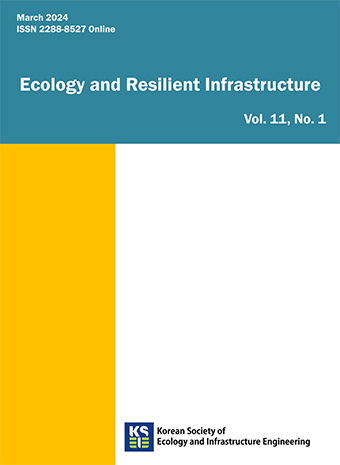Original Article
Abstract
References
Information
Han, M.S., Lee, H.R., Hong, S.S., Kim, Y.O., Lee, K., Choi, Y.K., Kim, S. and Yoo, K.I. 2002. Ecological studies on Togyo reservoir system in Chulwon, Korea. V. Seasonal changes of size fractionated standing crops and chlorophyll a of phytoplankton in Kyunan stream of Paldang river- reservoir systems and Togyo reservoir, Korea. Korean Journal of Environmental Biology 20: 91-99. (in Korean)
Jung, S.W., Kwon, O.Y., Lee, J.H. and Han, M.S. 2009. Effects of water temperature and silicate on the winter blooming diatom Stephanodiscus hantzschii (Bacillariophyceae) growing in eutrophic conditions in the lower Han River, South Korea. Journal of Freshwater Ecology 24: 219-226.
10.1080/02705060.2009.9664286Jung, S.W., Kim, B.H., Katano, T., Kong, D.S. and Han, M.S. 2008. Pseudomonas fluorescens HYK0210-SK09 offers species-specific biological control of winter algal blooms caused by freshwater diatom Stephanodiscus hantzschii, Journal of Applied Microbiology 105: 186-195.
10.1111/j.1365-2672.2008.03733.x18266701Schrader, K.K., Nanayakkara, N.D., Tucker, C.S., Rimando, A.M., Ganzera, M. and Schaneberg, B.T. 2003. Novel derivatives of 9, 10-anthraquinone are selective algicides against the musty-odor cyanobacterium Oscillatoria perornata. Applied and Environmental Microbiology 69(9): 5319-5327.
10.1128/AEM.69.9.5319-5327.200312957919PMC194965- Publisher :Korean Society of Ecology and Infrastructure Engineering
- Publisher(Ko) :응용생태공학회
- Journal Title :Ecology and Resilient Infrastructure
- Journal Title(Ko) :응용생태공학회 논문집
- Volume : 7
- No :1
- Pages :72-81
- Received Date : 2019-12-31
- Revised Date : 2020-03-13
- Accepted Date : 2020-03-20
- DOI :https://doi.org/10.17820/eri.2020.7.1.072




 Ecology and Resilient Infrastructure
Ecology and Resilient Infrastructure







